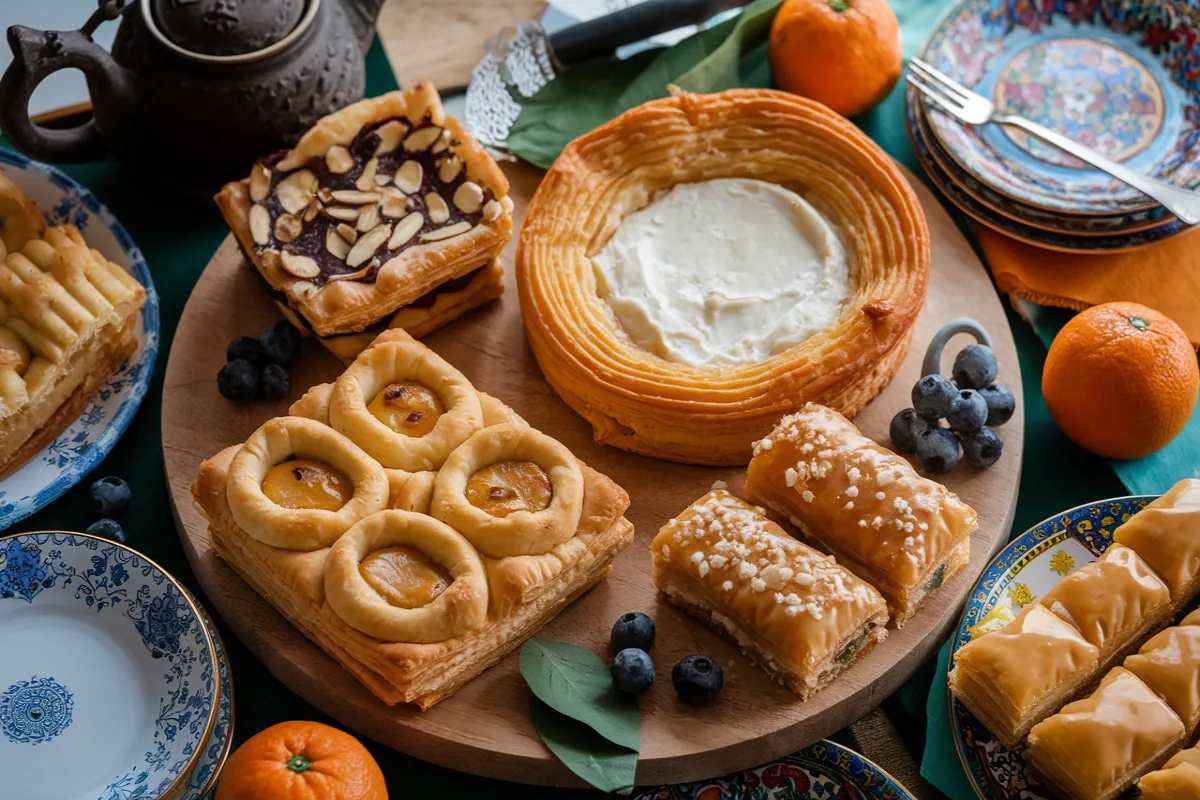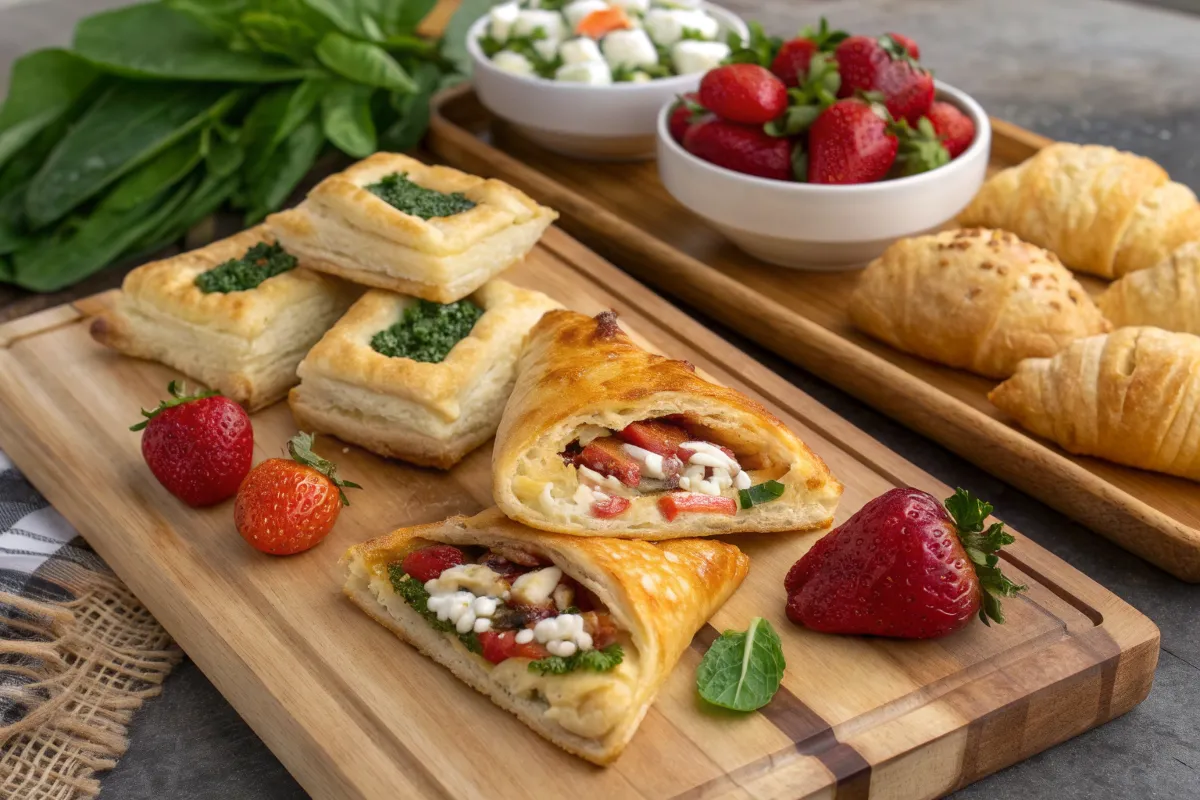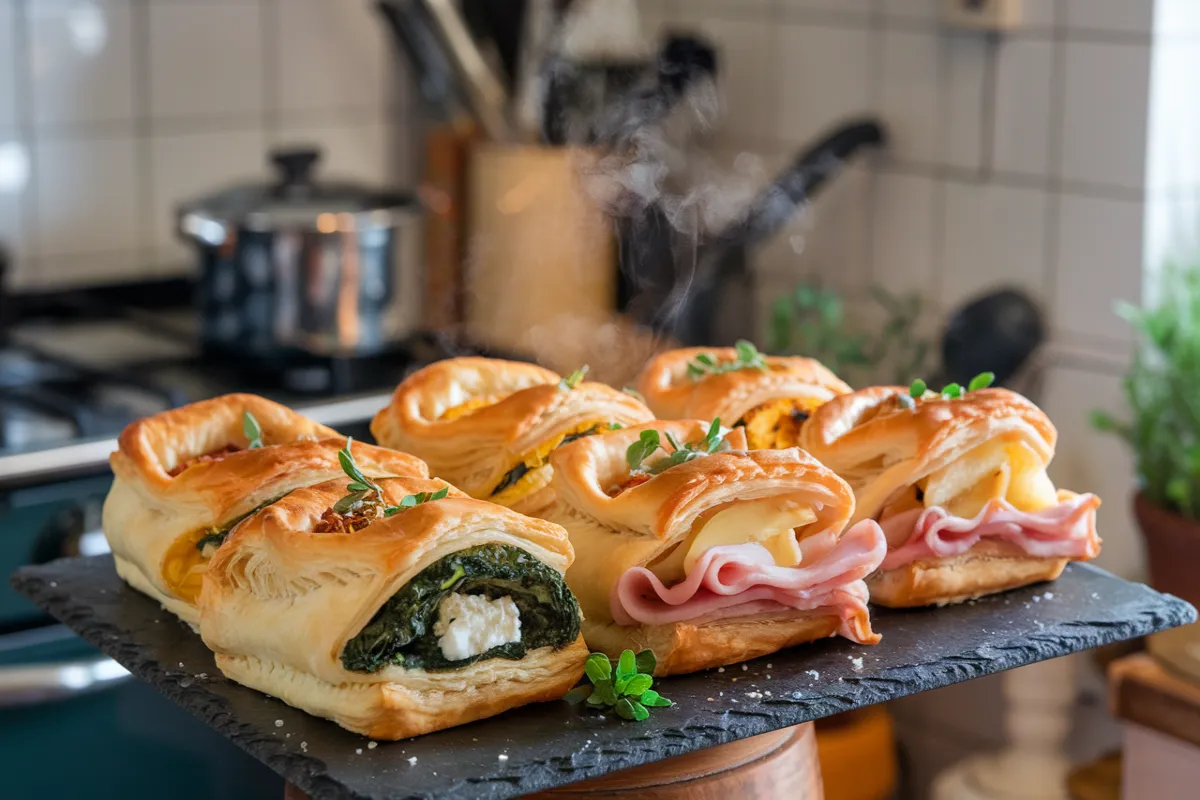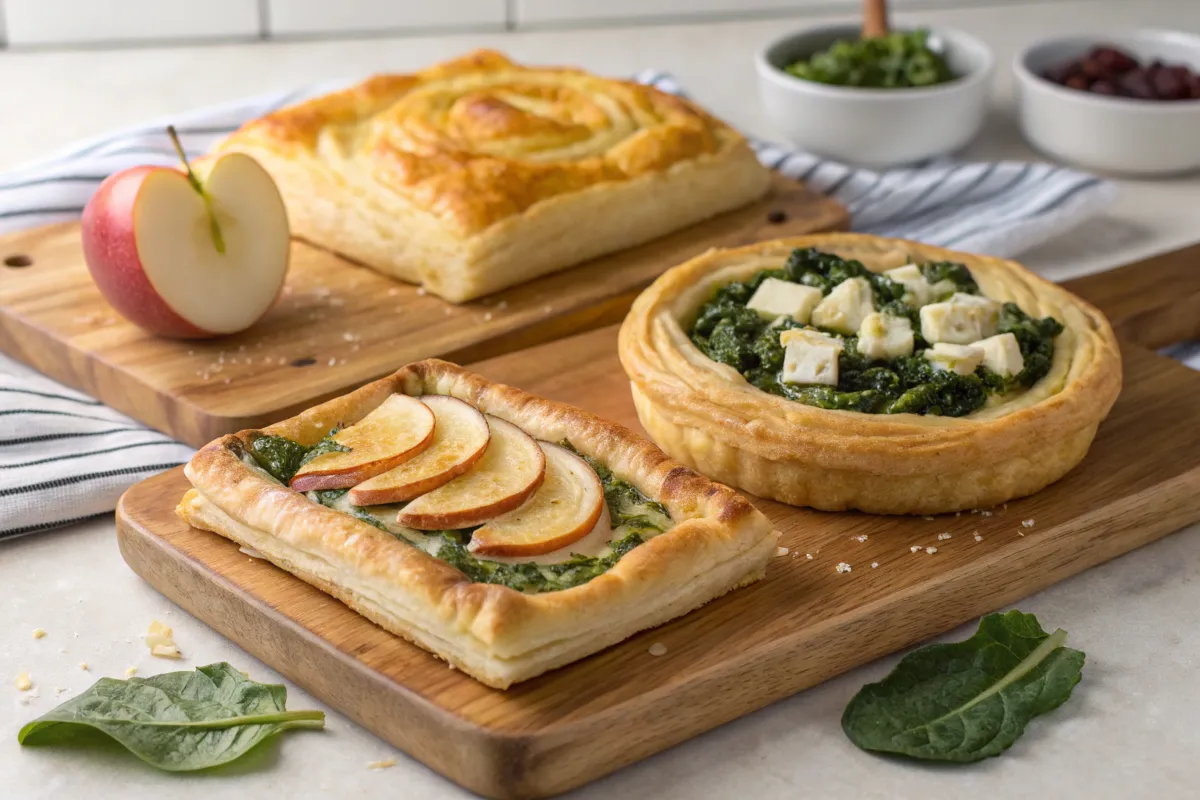Puff pastry is a versatile dough with layers of buttery goodness, perfect for crafting both sweet and savory delights. From creamy custards to hearty cheese fillings, the potential of puff pastry is boundless. In this article, we’ll explore mouthwatering puff pastry filling recipes, tips for crafting them, and techniques to ensure flawless results. Whether you’re a seasoned baker or a curious beginner, this guide will inspire you to create puff pastry magic. Let’s dive in!
Exploring the World of Puff Pastry Fillings
Exploring the World of Puff Pastry Fillings
Puff pastry has long been celebrated as one of the most adaptable bases in the culinary world. Its delicate layers, formed through the process of laminating dough and butter, create a flaky and crisp texture. But what makes puff pastry creations truly shine? The fillings, of course!
What is Puff Pastry?
Puff pastry is a laminated dough made by folding and layering butter within the dough. As it bakes, the butter melts, creating steam that puffs up the layers. The result? A crispy, golden pastry that serves as a perfect canvas for both sweet and savory fillings.
Store-bought puff pastry is a time-saver and works wonderfully for quick recipes. But if you’re up for a challenge, making your own puff pastry adds a rewarding homemade touch.
Importance of Fillings in Puff Pastry Creations
Fillings are the soul of puff pastry dishes. Without them, it’s just… dough! Sweet fillings like vanilla custard or chocolate ganache bring richness to desserts, while savory options like spinach and cheese create comforting snacks or appetizers.
The right filling complements the puff pastry without overpowering it. It’s all about balance: the pastry provides texture, while the filling offers flavor. And don’t forget, different cultures bring their own twist to puff pastry fillings, from the Middle East’s nutty baklava-inspired pastries to France’s almond pithiviers.
Sweet Puff Pastry Filling Recipes
Decadent Sweet Fillings for Puff Pastry
Sweet puff pastries are irresistible treats that combine flaky, golden layers with indulgent fillings. Whether you’re crafting desserts for special occasions or satisfying a sudden sweet craving, these sweet puff pastry filling recipes are sure to impress. From rich and nutty to light and fruity, the options are endless. Let’s explore some classic and innovative ideas!
Classic Almond Frangipane
Almond frangipane is a timeless filling that blends the nutty richness of almonds with a touch of sweetness. This creamy mixture, made with almond flour, butter, sugar, and eggs, pairs beautifully with the crisp layers of puff pastry.
You can use almond frangipane to create tarts, turnovers, or even traditional French pithiviers. Its subtle sweetness allows it to complement a variety of additional flavors, such as fresh fruit or a drizzle of honey.
Rich Chocolate Ganache
Few things are as decadent as puff pastry filled with velvety chocolate ganache. Made with just two ingredients—chocolate and cream—this filling adds a luscious, melt-in-your-mouth texture to any dessert.
To prepare chocolate-filled pastries, simply pipe the ganache onto the pastry, fold or shape as desired, and bake. The heat from the oven melts the chocolate slightly, creating a gooey, indulgent center.
Creamy Vanilla Custard
Vanilla custard is a classic choice for sweet puff pastries. Its smooth, creamy texture perfectly complements the crisp layers of the pastry. You can pipe it into turnovers, cream puffs, or even layer it between baked sheets of puff pastry to create mille-feuille.
The best part? You can infuse your custard with flavors like cinnamon, nutmeg, or even orange zest to customize it for any occasion. Vanilla custard-filled pastries are always a crowd-pleaser.
Fresh Fruit Compote Medley
For a light and fruity twist, fresh fruit compote is an excellent filling choice. Whether you prefer berries, apples, or stone fruits, a quick compote made by simmering fruit with sugar and a splash of lemon juice can transform your puff pastries.
This filling is versatile and can be combined with other elements like whipped cream or mascarpone cheese for extra indulgence. Plus, the vibrant colors of fruit compote add a pop of visual appeal to your creations.
Irresistible Savory Puff Pastry Filling Recipes to Elevate Your Creations
Golden puff pastry filled with irresistible savory ingredients is a match made in culinary heaven. This versatile dish can be tailored for any occasion—whether a fancy dinner party or a quick midweek snack. From gooey cheese-filled parcels to spiced meat concoctions, savory puff pastry filling recipes open the door to endless possibilities. Let’s dive into these delightful ideas that will have you reaching for seconds (or thirds)!
Spinach and Feta Cheese Blend
A classic combination, spinach and feta cheese blend perfectly for a savory puff pastry filling. This mixture is creamy, tangy, and loaded with nutrients, making it a fantastic option for appetizers or light meals.
To make this filling, sauté fresh spinach until wilted, then mix it with crumbled feta cheese, garlic, and a pinch of nutmeg. Spoon the mixture into the center of your pastry, fold, and bake until golden brown. The result is a crisp pastry with a rich, flavorful center.
Mushroom and Thyme Sauté
Earthy mushrooms and aromatic thyme make for a sophisticated and savory puff pastry filling. This option is particularly great for vegetarian-friendly appetizers or as a side dish.
Sauté finely chopped mushrooms with butter, garlic, onions, and a generous sprinkle of thyme until the mixture is dry and intensely flavorful. Use this filling for turnovers, pinwheels, or tarts. The rich umami flavors of the mushrooms balance beautifully with the buttery layers of the pastry.
Ham and Gruyère Cheese Mix
Ham and Gruyère cheese is a pairing that exudes comfort and elegance. The saltiness of the ham complements the nutty, creamy Gruyère cheese, creating a filling that works wonderfully for breakfast pastries or hearty snacks.
Simply dice ham and mix it with shredded Gruyère cheese, a bit of Dijon mustard, and a sprinkle of black pepper. Place the filling in your puff pastry, fold or roll as desired, and bake until the cheese is melted and bubbly.
Spiced Potato and Pea Filling
Inspired by Indian samosas, spiced potato and pea filling is a bold and flavorful option for puff pastries. This savory filling combines mashed potatoes, peas, and a medley of spices like cumin, coriander, turmeric, and chili powder for a warm, spiced kick.
Cook the mixture until well-blended, then cool it slightly before spooning it into puff pastry. These spiced pastries are perfect as appetizers or snacks and are sure to impress guests with their vibrant flavors.
International Puff Pastry Delicacies
Global Inspirations for Puff Pastry Fillings
Puff pastry isn’t just a culinary staple; it’s a global canvas for rich, diverse flavors. From France to the Middle East, different cultures bring unique twists to puff pastry filling recipes. These international delights not only celebrate regional ingredients but also showcase how versatile puff pastry can be. Let’s take a delicious journey around the world!
French Pithivier with Almond Cream
The pithivier is a French classic, named after a town in France. This round puff pastry is traditionally filled with almond cream, also known as frangipane. Its golden, domed shape and decorative scoring make it as visually stunning as it is delicious.
To prepare, layer almond frangipane between two puff pastry circles, seal the edges, and create a pattern using a sharp knife. Bake until the pastry is puffed and golden. The result is a crisp exterior that gives way to a creamy, nutty filling.
Spanish Miguelitos with Cream Filling
Originating from La Mancha, Spain, miguelitos are simple yet delightful puff pastry desserts filled with cream and topped with powdered sugar. These small, square pastries are light, airy, and subtly sweet, making them a popular treat across Spain.
To make miguelitos, bake puff pastry sheets and slice them into squares. Once cooled, fill them with pastry cream or whipped cream and sprinkle with powdered sugar for a delicate finish.
Middle Eastern Baklava-Inspired Nuts and Honey
The flavors of baklava translate beautifully into a puff pastry filling. This Middle Eastern-inspired creation combines chopped nuts—like pistachios, walnuts, or almonds—with honey, cinnamon, and a hint of orange blossom water.
Use the nut mixture as a filling for puff pastry rolls or triangles, and bake until golden and crispy. The combination of flaky pastry and sweet, nutty filling mirrors the richness of traditional baklava while offering a new texture twist.
Italian Sfogliatella with Ricotta and Citrus
Sfogliatella, also known as “lobster tail,” is an iconic Italian pastry filled with a creamy ricotta and citrus mixture. While traditionally made with a different type of dough, puff pastry offers a quick alternative to recreate this beloved dessert.
To prepare, mix ricotta cheese with sugar, orange zest, and a touch of vanilla extract. Fill the puff pastry, fold into the signature shape, and bake until golden. The creamy filling and zesty notes of citrus perfectly complement the flaky pastry.
Tips and Techniques for Perfect Puff Pastry Fillings
Mastering Puff Pastry Fillings
Creating puff pastries with delectable fillings requires more than just great recipes. The right techniques ensure that your pastries are not only flavorful but also visually stunning and perfectly baked. From balancing flavors to preventing leaks, mastering these skills will elevate your puff pastry filling recipes to a professional level.
Balancing Flavors and Textures
The key to a memorable puff pastry creation is achieving a balance between the flaky layers of the pastry and the flavors of the filling. Pair rich, creamy fillings like custard or chocolate with tart elements like berries or citrus to create contrast. Similarly, for savory fillings, balance salty ingredients with mild or slightly sweet components.
Texture is equally important. A crunchy filling like nuts or a crisp vegetable layer can add a delightful bite to contrast the soft pastry. Avoid overly wet or heavy fillings, as they can overpower the delicate layers of puff pastry.
Ensuring Fillings Don’t Sog the Pastry
One of the biggest challenges when working with puff pastry is keeping it crisp and flaky, even with moist fillings. The trick is to minimize excess moisture and create a barrier between the pastry and the filling.
Here are a few techniques:
- Pre-cook or drain fruits and vegetables to reduce water content.
- Use a layer of breadcrumbs, ground nuts, or even a light dusting of flour under the filling to absorb moisture.
- Allow cooked fillings to cool completely before placing them on the pastry.
Proper Sealing Techniques to Prevent Leakage
Sealing the edges of puff pastry properly is crucial to prevent the filling from leaking during baking. Whether you’re making turnovers, pockets, or pies, a tight seal ensures that your pastry holds its shape and keeps the filling intact.
Here’s how to seal puff pastry like a pro:
- Use a beaten egg or water along the edges as an adhesive before pressing them together.
- Gently press with a fork or crimp the edges with your fingers for a decorative and secure seal.
- Avoid overfilling, as excess filling can make it difficult to close the pastry properly.
Adjusting Baking Times for Filled Pastries
Baking puff pastry with fillings requires slight adjustments to standard baking times. Since the filling adds density, it’s essential to ensure the pastry is fully cooked without overbrowning the top.
Here are some tips for baking perfection:
- Preheat the oven to the recommended temperature for puff pastry (usually around 400°F/200°C).
- Rotate the tray halfway through baking to ensure even cooking.
- Tent the pastry lightly with foil if it browns too quickly while the filling is still cooking.
FAQs on Puff Pastry Fillings
When it comes to creating puff pastry filling recipes, questions often arise about preparation, storage, and customization. Below are answers to some of the most frequently asked questions to help you achieve puff pastry perfection every time.
Can I use frozen puff pastry for these recipes?
Absolutely! Frozen puff pastry is a convenient option and works wonderfully for most recipes. Be sure to thaw it in the refrigerator overnight or at room temperature for about 30–40 minutes before use. Avoid letting it become too soft, as it can stick or lose its structure.
How do I prevent puff pastry from becoming soggy?
To keep your puff pastry crisp, start with the right techniques. Use cooled, thick fillings to minimize moisture, and avoid overfilling. Creating a barrier with a light layer of breadcrumbs, ground nuts, or even brushing the dough with egg wash can help keep the pastry dry and flaky.
What is the best way to store filled puff pastry?
Store filled and baked puff pastry in an airtight container at room temperature for up to two days. For longer storage, refrigerate them for up to five days, though they may lose some crispness. Reheat in the oven to restore their flaky texture.
Can puff pastry be made gluten-free?
Yes, gluten-free puff pastry is available in some stores or can be made at home using gluten-free flour blends. The process is similar to traditional puff pastry but requires additional care to ensure the dough remains pliable. The texture may differ slightly, but it’s a great alternative for those with dietary restrictions.
How thick should I roll out puff pastry for fillings?
For most recipes, puff pastry should be rolled out to about 1/8 to 1/4 inch thick. Thinner dough ensures a light, crisp result, while slightly thicker pastry works well for heartier fillings or pies.
Is it necessary to egg wash puff pastry before baking?
While not strictly necessary, egg washing puff pastry adds a beautiful golden sheen and helps seal the edges. Use a beaten egg mixed with a tablespoon of water or milk, and brush lightly over the surface before baking.




